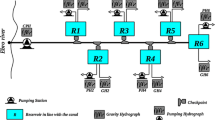Abstract
Check gates being installed in a main open canal work to maintain water at a constant level in order to ensure water distribution to secondary canals. This type of water distribution is called the constant upstream water level control in Japan, and this type is suitable for supply-oriented water control. Although this type can supply more water compared to the canal structural size, the water supply and distribution schedule must be kept rigidly, and farm turnouts in upstream reaches are apt to withdraw more water than allocated, which leads to unfair water distribution. Recently, tele-meter and tele-control (TM/TC) systems have become more easily applicable to an irrigation system, and in some key points TM/TC devices are actually equipped to check and control water flow. However, their abilities in reality are not fully utilized to respond to the earnest requests of farmers, such as, flexible and labor-saving water use, or fair water distribution between upstream and downstream areas. This study aims to seek useful managing methods to solve the above problems by fully utilizing TM/TC devices to be installed at all check gates. These devices transmit data and commands between a central office and terminals, or they process data independently to control structure at each terminal. Firstly, the A Yousui, the most advanced irrigation system in Japan, is kept in mind, and a new operation system is proposed for demand-oriented water control, which can automatically respond to water demands but also can convey a relatively large flow rate. Secondly, for the T Yousui, a popular irrigation system, another operation system is proposed to solve the unfair distribution problem between upstream and downstream areas. These proposals are led based on numerical experiments using a numerical model, the facilities’ data in place, and water distribution records.













Similar content being viewed by others
References
Harder J, Shand M, Buyalski C (1970) Automatic downstream control of canal check gates by the hydraulic filter offset (HyFLO) method. A paper to be presented at the 5th technical conference, U.S. Committee on irrigation, drainage, and flood control, Denver, Colorado
Inagaki H, Masuda K, Konishi K, Ootuka A, Ogura N, Akiyoshi Y (2002) Performance evaluation of check gate in canal using a numerical model: part I: float-operated constant upstream level control gate in indirect level action. J Rainwater Catchment Syst 8(1):35–45
Inagaki H, Izumi H, Masuda K (2011) Performance evaluation of check gate in canal using a numerical model: part II: float-type constant upstream and down stream water stage control gate. J Rainwater Catchment Syst 7(1):33–42
Naka T (2010) Engineering design on pipelines of Kuzuryu-gawa irrigation project. In: Proceedings of JSIDRE, pp 54–55
Ogata H (1991) Farm pond—matchmaker of water demand and water supply. Workshop of agricultural water utilization, JSIDRE, pp 19–22
Rogers D, Goussard J (1995) Canal control algorithms currently in use. In: The 1st international conference on water resources engineering, ASCE, San Antonio, Texas
U.S.B.R. Department of the Interior (1991a) Canal systems automation manual, vol 1, pp 16–17
U.S.B.R. Department of the Interior (1991b) Canal systems automation manual, vol 1, p 37
Wongtragoon U, Kubo N, Tanji H (2009) Performance diagnosis of Mae Lao irrigation Scheme in Thailand. (I) Development of unsteady irrigation water distribution and consumption model. Paddy Water Environ 8(1):1–13
Yoshino H, Naka T, Goto M, Iwasaki K (1987) Necessity and calculation method of buffer volume in a complex canal system. J JSIDRE 55(2):131–138
Acknowledgements
The author wishes to thank all staff members of the Aichi Irrigation General Management Office, Japan Water Agency, for their assistance providing valuable data and also thank staff members of the West Kanto Land Improvement Survey Management Office, Kanto Regional Agricultural Administration Office, and Iwata Yousui East Land Improvement District for their cooperation.
Author information
Authors and Affiliations
Corresponding author
Rights and permissions
About this article
Cite this article
Kubo, N. Effective and convenient water management by tele-metering and controlling check gates in main open canal. Paddy Water Environ 17, 109–120 (2019). https://doi.org/10.1007/s10333-019-00703-8
Received:
Revised:
Accepted:
Published:
Issue Date:
DOI: https://doi.org/10.1007/s10333-019-00703-8




